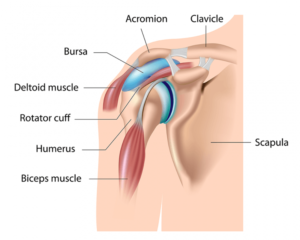Most people think of bursitis as a primary condition, because they have heard their friends and family complaining of “bursitis pain”. Although it could be a primary problem, bursitis rarely stands alone as a primary diagnosis. Instead, think of bursitis as a secondary issue, as other orthopedic conditions cause bursitis itself. Often there are several problems in a joint that all combine to cause bursitis. To understand exactly what bursitis is, we have to analyze how it begins.
Bursitis is named from an inflammation of the bursae sacs, which are small fluid-filled sacs surrounding joints in the body. The larger joints are more prone to bursitis, like the hips, shoulders, elbows, knees, etc. However, the most common joints in the body that are susceptible to bursitis are the shoulders and hips, because they are the worst lever systems in the body and therefore more prone to injury.
 Any kind of joint breakdown, arthritis, tendonitis, etc. will cause excess fluid to accumulate in the joint, which then drains into the bursae sacs around that particular joint. This excess fluid in each bursae sac causes swelling, inflammation, and edema of the bursae sac called bursitis. So, because this process usually happens in this order, then a diagnosis of bursitis is seldom a primary diagnosis. And the more injuries a person has around a joint, the more likely that they are to get bursitis whenever that joint is overloaded from a sport, activity, or daily life.
Any kind of joint breakdown, arthritis, tendonitis, etc. will cause excess fluid to accumulate in the joint, which then drains into the bursae sacs around that particular joint. This excess fluid in each bursae sac causes swelling, inflammation, and edema of the bursae sac called bursitis. So, because this process usually happens in this order, then a diagnosis of bursitis is seldom a primary diagnosis. And the more injuries a person has around a joint, the more likely that they are to get bursitis whenever that joint is overloaded from a sport, activity, or daily life.
Since we know that bursitis is caused by other conditions and injuries, the question then becomes how to treat it. Well, the first thing that we do here at CardioFlex Therapy is to diagnose the underlying conditions that are causing bursitis, like the tendonitis, arthritis, cartilage breakdown, ligament injuries, tendon injuries, muscle strains, soft tissue tears, joint injuries, etc. Then, we will treat the underlying conditions and bursitis simultaneously to get the best result possible.
For the underlying conditions, Physical Therapy & Occupational Therapy is performed by utilizing modalities, progressive strengthening exercises, functional movements, and sport-specific rehab. This will help the patient to get back to their former level of function, and hopefully beyond. For bursitis, we use modalities to decrease the inflammation such as Ice, Moist Heat, Ultrasound, Electrical Stimulation, Cold Laser, Iontophoresis, Anodyne Therapy, Massage Therapy, and Kinesiotaping.
At CardioFlex Therapy, we’ve gotten great results from treating patients with bursitis. A large part of our success has been in our diagnosis of not only bursitis but also the underlying injuries and conditions that are causing it.
For more info visit: www.cardioflextherapy.com
